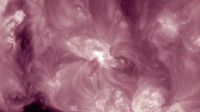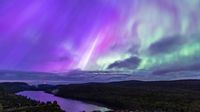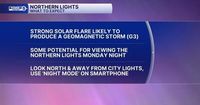Millions of skywatchers across the Northern Hemisphere are bracing for a rare celestial spectacle as a powerful solar storm, fueled by a series of dramatic eruptions on the Sun, is set to hit Earth late on Monday, September 1, 2025. The event, which scientists say could be one of the most energetic of recent years, promises not only to dazzle with vibrant auroras stretching far beyond their usual polar haunts, but also to pose potential risks to power grids, satellites, and communications systems.
According to the National Oceanic and Atmospheric Administration’s (NOAA) Space Weather Prediction Center, the excitement began on August 30, when sunspot region AR 4199 unleashed a long-duration M2.7-class solar flare. As reported by The Watchers, the flare erupted at 20:02 UTC and was soon followed by an asymmetric full halo coronal mass ejection (CME)—a massive burst of plasma and magnetic field from the Sun’s corona—observed at around 20:30 UTC. This CME, aimed directly at Earth, is expected to make its impact after 20:00 UTC on September 1, 2025, with the strongest effects anticipated in the early hours of September 2.
But what makes this solar event truly exceptional, as India Today explains, is the occurrence of a so-called "cannibal CME." In this rare phenomenon, a faster CME overtakes a slower one, merging into a more powerful and unpredictable blast. "Think of it like the Sun sneezing out billions of tons of charged particles into space," India Today elaborates. When these charged particles, racing at millions of kilometers per hour, collide with Earth’s magnetic field, they can trigger geomagnetic storms—disturbances that ripple through our planet’s magnetosphere, the invisible shield that protects us from solar radiation.
NOAA has issued a G2 (moderate) geomagnetic storm watch for September 1, escalating to G3 (strong) as the main body of the storm passes on September 2. The Kp index, a standard measure of geomagnetic activity, is forecast to peak at 6.67 (G3 storm) between 06:00 and 09:00 UTC (2 a.m. to 5 a.m. EDT) on September 2, as reported by Space.com. The UK Met Office, echoing NOAA’s caution, expects Earth’s auroral oval—the region around the magnetic poles where auroras form—to be "significantly enhanced" after the CME’s arrival, raising the possibility of visible auroras as far south as East Anglia, the Midlands, and Wales, provided skies remain clear.
For those eager to catch the northern lights, the opportunity is truly extraordinary. NOAA’s aurora forecast map suggests that auroras could be visible across 18 U.S. states, including Alaska, Montana, North Dakota, Minnesota, Wisconsin, Michigan, Maine, South Dakota, Vermont, New Hampshire, Idaho, Washington, Oregon, New York, Wyoming, Iowa, Nebraska, and Illinois. The Economic Times notes that with the storm’s exceptional strength, the auroral spectacle could extend even farther south, with sightings possible in states like Virginia, Missouri, and Colorado, as well as in similar latitudes across Europe and Asia.
"Clear areas would be New England, particularly northern New England, the Great Lakes area and parts of Montana," Bryan Jackson, a meteorologist at the Weather Prediction Center, told The New York Times. However, he warned that cloud cover could complicate viewing in some regions, especially across the Dakotas and the Northwest. By Monday night, skies across the Great Lakes and parts of the northern Midwest should be relatively clear, offering prime viewing conditions. For Northeast Ohio, News 5 Cleveland reported that Monday night’s mostly clear skies could provide a rare chance to see the aurora, though Tuesday’s forecast is less favorable due to increasing clouds.
For the best chance of witnessing the aurora, experts recommend heading to a location far from city lights, finding a north-facing view with a clear horizon, and keeping an eye on the sky between midnight and 2 a.m. local time. Patience is key, as auroras often appear in waves and may start faint before intensifying. Using a space weather app that provides real-time aurora forecasts based on your location can also help maximize your chances, as advised by The Economic Times.
But the storm’s impact isn’t limited to the night sky. As The Watchers details, G3 geomagnetic storm conditions can cause voltage irregularities in power systems, trigger false alarms on protection devices, and pose risks for spacecraft, including surface charging, increased drag on low Earth-orbit satellites, and orientation difficulties. GPS and satellite navigation systems may experience intermittent disruptions, with potential loss of lock and increased range errors. High frequency radio communications could also be affected, resulting in patchy or degraded signals for users on the ground.
Satellite operators and grid managers are not taking any chances. "Satellite operators and grid managers are actively monitoring the storm’s progress and preparing contingency plans," India Today reports, emphasizing that while most disruptions are expected to be minor and temporary, the event serves as a reminder of the Sun’s capacity to influence modern technology. With the Sun approaching the peak of Solar Cycle 25, scientists warn that more such surprises could be in store over the coming months.
Solar activity is forecast to remain at moderate levels through September 2, with a 65% chance of additional M-class and a 20% chance of X-class solar flares, according to The Watchers. This means that while the current storm is grabbing headlines, more solar fireworks could be on the horizon.
For many, however, the real draw is the chance to witness the aurora borealis—those shimmering curtains of green, red, blue, and purple that have inspired awe for centuries. As The New York Times explains, oxygen in the atmosphere produces green or red light during an aurora, while nitrogen creates shades of blue and purple. These colors dance across the sky when the energetic particles from the Sun interact with Earth’s magnetic field, making the invisible visible in a breathtaking nocturnal display.
With so many variables—solar activity, atmospheric conditions, cloud cover, and even light pollution—there’s no guarantee that everyone will catch the show. But for one or two nights, millions stand a chance to see the sky light up in ways rarely witnessed outside the far north. And even as scientists and engineers keep a watchful eye on the potential technological impacts, the world is reminded of the Sun’s dual role as both a provider of life and an occasional disruptor of our earthly routines.
For those lucky enough to catch the aurora, it’s a spectacle that lingers long after the lights fade—a vivid reminder of our place under an ever-changing cosmic sky.






